Dwarf gourami (lat. Trichogaster lalius) — is a kind of small Anabantoidei fish of Osphronemidae family. Although the fish is very attractive and quite peaceful, it’s rather demanding – care requires a lot more attention, than the one of other Anabantoidei fish kinds.
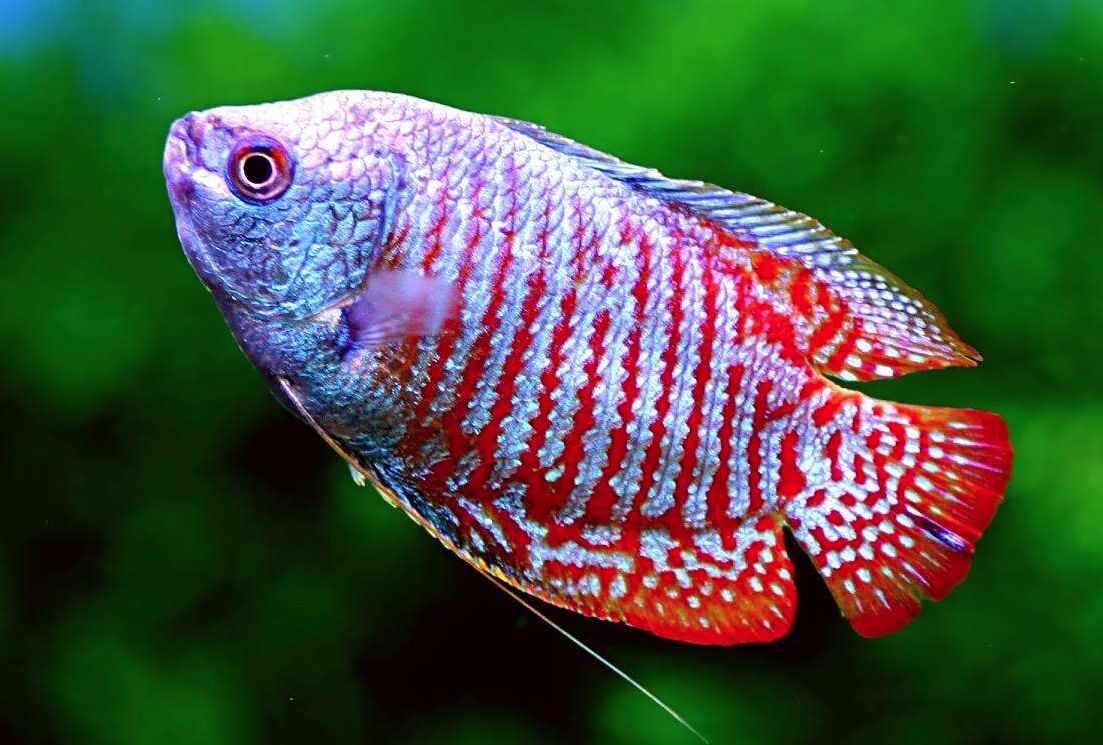
Contents
Habitat in the wild
Dwarf gouramis (Trichogaster lalius) belong to the family Osphronemidae, commonly known as the gourami family. The gourami family includes various species of freshwater fish known for their vibrant colors, labyrinth organs, and distinctive behaviors.
Within the family Osphronemidae, dwarf gouramis belong to the subfamily Macropodinae, which also includes other gourami species like honey gouramis (Trichogaster chuna) and moonlight gouramis (Trichogaster microlepis). These species share similar traits such as the labyrinth organ, which allows them to breathe air from the water’s surface, and the characteristic elongated pelvic fins that form a “feelers” appearance.
Dwarf gouramis are rather spread in Pakistan, in the North of India and Bangladesh. It was considered earlier that fish can be also encountered in Nepal and Malaysia, however nowadays it’s more likely that there was wrong identification of the fish. There are also some wild populations in Singapore, USA and Colombia.
Inhabits mainly in slow, thickly planted waters including ponds, bogs, dykes, streams and irrigation channels. The natural habitat of dwarf gouramis is rich in aquatic vegetation, including floating plants like water lettuce and water hyacinth, as well as submerged plants like Vallisneria and Hygrophila. These plants provide shelter, breeding sites, and food sources for the gouramis.
The habitat of dwarf gouramis often includes submerged roots, fallen branches, and dense vegetation, providing them with ample hiding spots. These hiding places serve as shelters from predators and create territories for the fish.
Dwarf gourami has a quite interesting feature – it can hunt insects flying over water. They do it like this: the fish freezes near water surface waiting for its prey. Once an insect is within grasp, the fish splits in it with a water thread and knocks it down on the water surface.
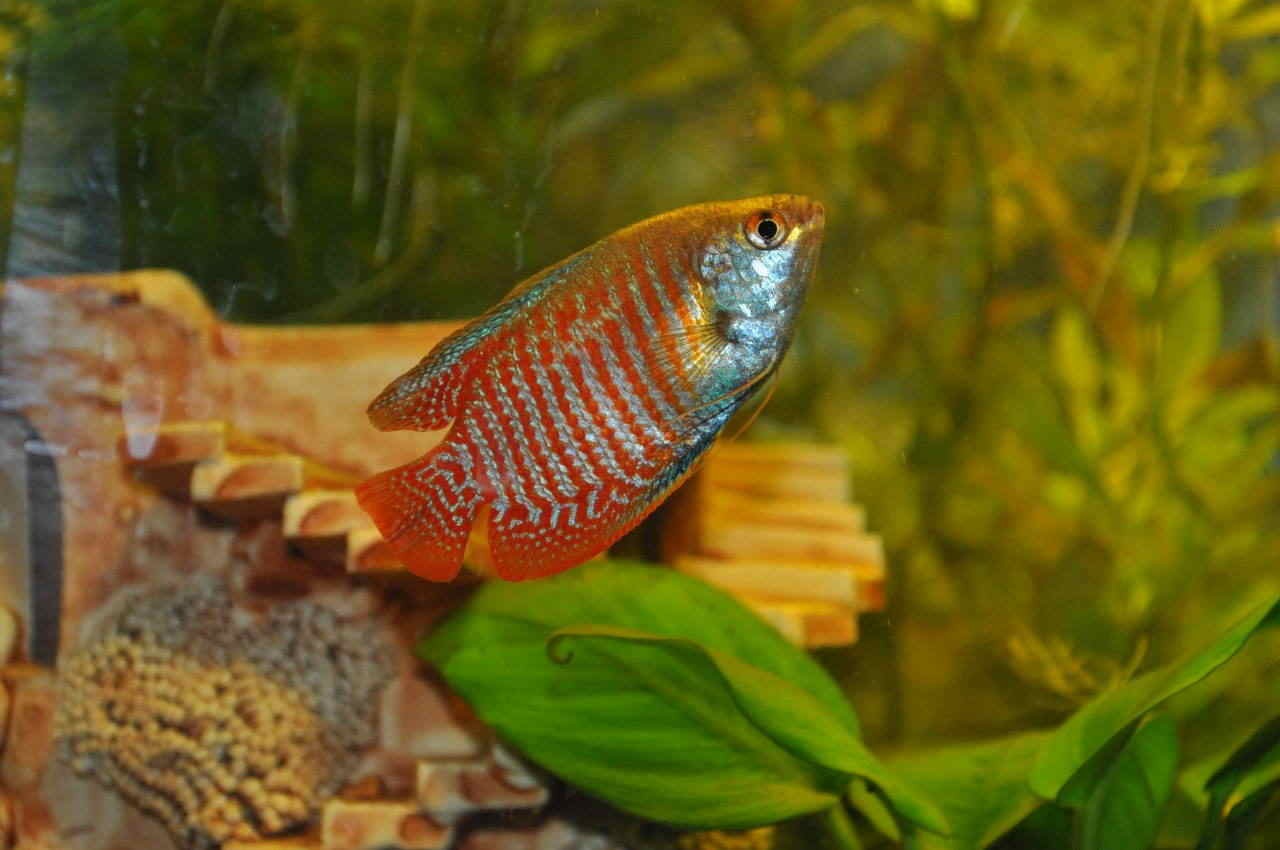
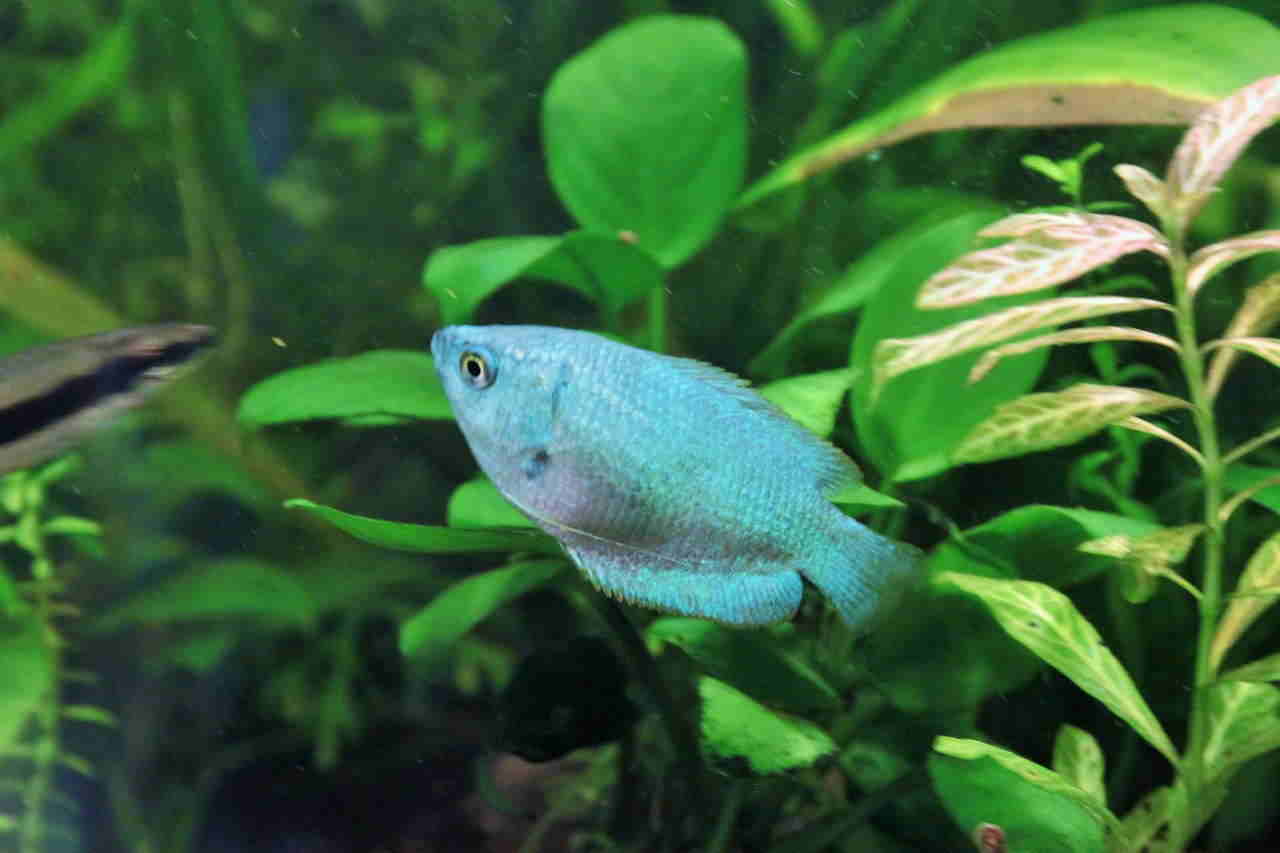
Description
How long do dwarf gouramis live?
Dwarf gouramis typically have an average lifespan of about 3 to 5 years in captivity. However, with proper care and a suitable environment, it is possible for some individuals to live longer, potentially reaching up to 6 years or even more. Providing a balanced diet, maintaining optimal water conditions, and ensuring a stress-free environment can contribute to the longevity and well-being of dwarf gouramis. It’s important to note that individual lifespan can vary, and factors such as genetics, overall health, and environmental conditions can influence the lifespan of these fish.
How big do dwarf gouramis get?
Trichogaster lalius are relatively small fish, and their size is one of the reasons they are popular in the aquarium hobby. Dwarf gourami male max size may be up to 7.5 centimetres (3.0 in) and the female is smaller, about 6 cm (2.25 in) long.
How fast do dwarf gouramis grow?
Dwarf gouramis (Trichogaster lalius) have a relatively slow growth rate compared to some other fish species. The rate of growth can vary depending on several factors, including genetics, diet, water conditions, and overall care.
In general, dwarf gouramis will experience the most rapid growth during their early stages of life. Within the first few months, they can grow from small fry to around 1 inch (2.5 centimeters) in length. As they mature, their growth rate slows down, and they continue to grow gradually.
Under optimal conditions with proper nutrition and care, dwarf gouramis can reach their adult size of 2 to 3 inches (5 to 7.5 centimeters) within the first year or two of their life. However, it’s important to note that individual growth rates can vary, and some dwarf gouramis may take slightly longer to reach their full size.
Body is tall, oval shaped, flattened from sides.
The dorsal and anal fin have long base. The male is a bit larger and brighter colored, than the female one. Pelvic fin rays are located in front of pectoral fins. The dwarf gourami has horizontal red and sea-green stripes along all its body, which are also seen on its fins. Dorsal, anal and fluke fins have red edgings.
Dwarf gourami types
There are several color variants, or “types,” of dwarf gouramis available in the aquarium trade. These variations have been selectively bred over time to showcase specific colors or patterns.
Here are some common types of dwarf gouramis:
- Flame Dwarf Gourami: This type displays vibrant red-orange coloration, resembling flames, with vertical dark stripes on the body.
- Powder Blue Dwarf Gourami: It features a light blue body color with horizontal dark blue stripes.
- Neon Blue Dwarf Gourami: This type exhibits a bright, iridescent blue coloration across the body.
- Red Dwarf Gourami: This type displays a deep red coloration throughout the body.
These are just a few examples, and there may be other variations available depending on the breeders and local availability. It’s important to note that while these color variations may be visually appealing, they may be more susceptible to health issues than their wild-type counterparts. When choosing a type of dwarf gourami, ensure you select healthy individuals from reputable sources and provide them with appropriate care and conditions to ensure their well-being.
| Characteristic | Description |
|---|---|
| Scientific Name | Trichogaster lalius |
| Size | Typically reach about 2-3 inches (5-7.5 cm) in length |
| Lifespan | Average lifespan is around 3-5 years, but can live longer with proper care |
| Coloration | Males have vibrant colors with iridescent patterns, while females are more subdued in color |
| Body Shape | Elongated body with a laterally compressed shape |
| Labyrinth Organ | Possess a specialized organ called the labyrinth organ, enabling them to breathe air |
| Behavior | Generally peaceful, but males can be territorial and may exhibit aggression during breeding |
| Compatibility | Can be kept with other peaceful community fish, but avoid fin-nipping tank mates |
| Water Parameters | Temperature: 77-82°F (25-28°C), pH: 6.0-7.5, Water hardness: 5-15 dGH |
| Feeding | Omnivorous diet consisting of high-quality dry flakes or pellets, supplemented with live/frozen foods |
| Habitat | Slow-moving streams, ponds, and rice paddies in South Asia |
| Reproduction | Bubble nest builders, males create bubble nests for egg fertilization and parental care |
| Common Varieties | Flame Dwarf Gourami, Powder Blue Dwarf Gourami, Neon Blue Dwarf Gourami, etc. |
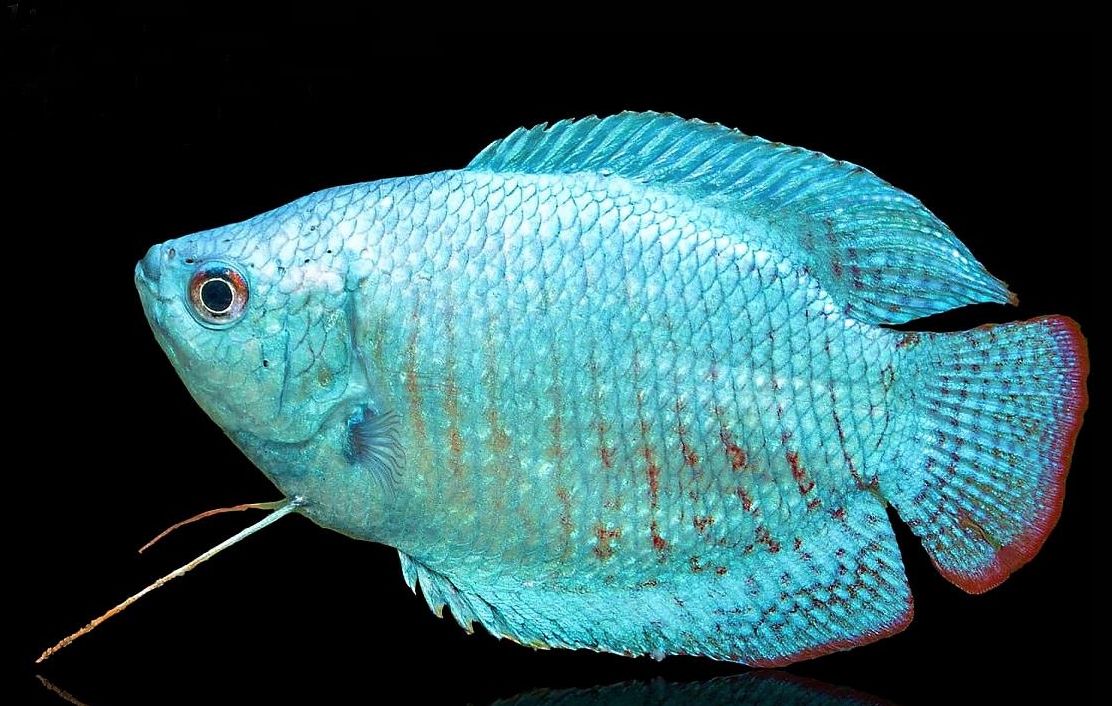
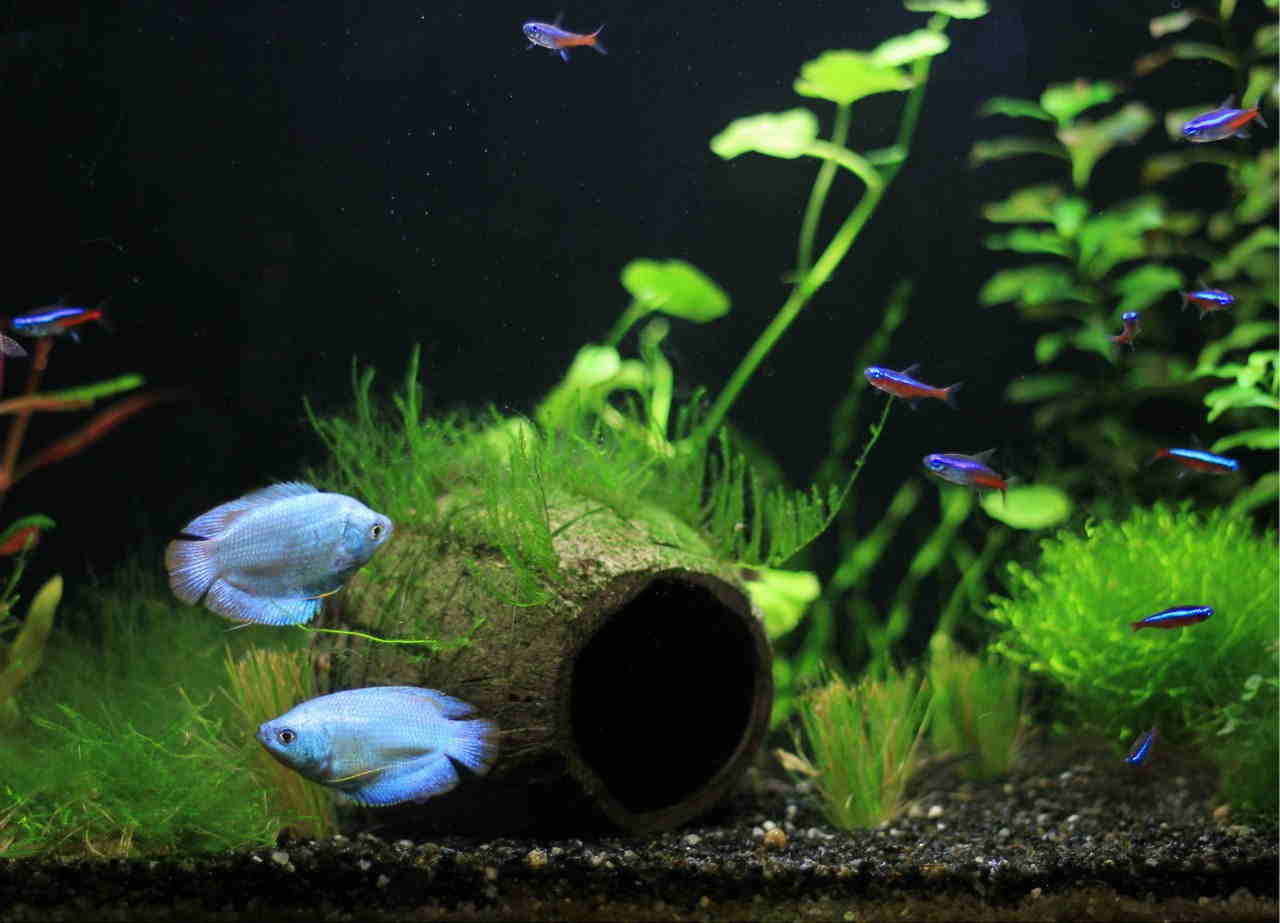
Care and keeping in a tank
Tank size
Dwarf gouramis can be kept in aquariums as small as 10 gallons, but providing a larger tank is generally recommended to ensure optimal space and swimming area for these fish. The tank size depends on various factors, including the number of dwarf gouramis you plan to keep and the presence of other tank mates.
Here are some guidelines for dwarf gourami tank sizes:
- Individual dwarf gourami: If you plan to keep a single dwarf gourami as the sole inhabitant of the tank, a minimum tank size of 10 gallons (38 liters) can be suitable. However, a larger tank, such as a 15-20 gallon (57-76 liters), provides more swimming space and is generally preferred.
- Multiple dwarf gouramis: If you wish to keep multiple dwarf gouramis, it’s important to consider their territorial nature. Keeping multiple males together can lead to aggression and territorial disputes. In such cases, it’s recommended to provide a larger tank size, such as a 20-gallon (76-liter) long tank, to allow for adequate space and the establishment of individual territories. It’s generally advised to keep only one male dwarf gourami in a community tank.
- Community tank: If you plan to keep dwarf gouramis in a community aquarium with other peaceful fish species, a larger tank is necessary to accommodate both the gouramis and their tank mates. A 20-gallon (76-liter) long tank or larger is generally recommended to provide sufficient space for multiple fish and minimize potential aggression.
Remember that the tank size is not the only factor to consider. Providing appropriate hiding places, plants, and other tank decorations also contribute to creating a comfortable and enriched environment for dwarf gouramis. Regular monitoring of water quality and proper maintenance practices are essential regardless of the tank size to ensure the well-being of your fish.
Water parameters
The following water parameters are preferable: temperature 22 – 27°C; pH: pH 6.5 – 7.5 and water hardness: 2 – 18°H. Perform regular partial water changes of 20-30% every one to two weeks to maintain water quality and remove accumulated toxins.
Tank decor
Just like all the other Anabantoidei they won’t inhabit in a tank with strong water flow, since the fish is rather timid and therefore they need some dark tank bottom substrate and some fluctuants that’ll darken the tank space. A fine-grained substrate, such as sand or smooth gravel, is ideal. It mimics their natural habitat and allows them to forage for food more easily.
Provide a moderate level of lighting, preferably with a natural spectrum, to support plant growth and enhance the colors of your dwarf gouramis.
Putting some snags, small tree branches, leaves and etc. into the tank will help to simulate the natural environment of fish habitat in the wild. Dwarf gouramis are shy fish and appreciate places to hide. Include caves, driftwood, and dense vegetation to offer hiding spots and create territories. It is crucial that the tank has lots of covers to decrease the chances of males chasing their females.
Incorporate live aquatic plants, such as Java moss, Anubias, or Amazon sword, to create a natural and visually appealing environment. Plants provide hiding spots and help maintain water quality by absorbing nitrates.
Diet
In the wild is omnivorous – it feeds on small insects, insect larvae, crustaceans, algae, and plant matter.
However, dwarf gourami is quite ok with the majority of fish food. You may use some high quality feed as a basic of the diet and add sometimes small sized live and frozen feed into it. A staple diet for dwarf gouramis can consist of high-quality dry flakes or pellets specifically formulated for tropical fish. Look for products that contain a mix of protein sources, vitamins, and minerals to meet their nutritional needs.
As for the blood worms, some breeders consider them to be harmful for the fish GIT and they avoid giving this kind of feed to dwarf gourami. However, keep in mind that fish is prone to gluttony and obesity, so you mustn’t overfeed the fish and it should have a hunger day once a week.
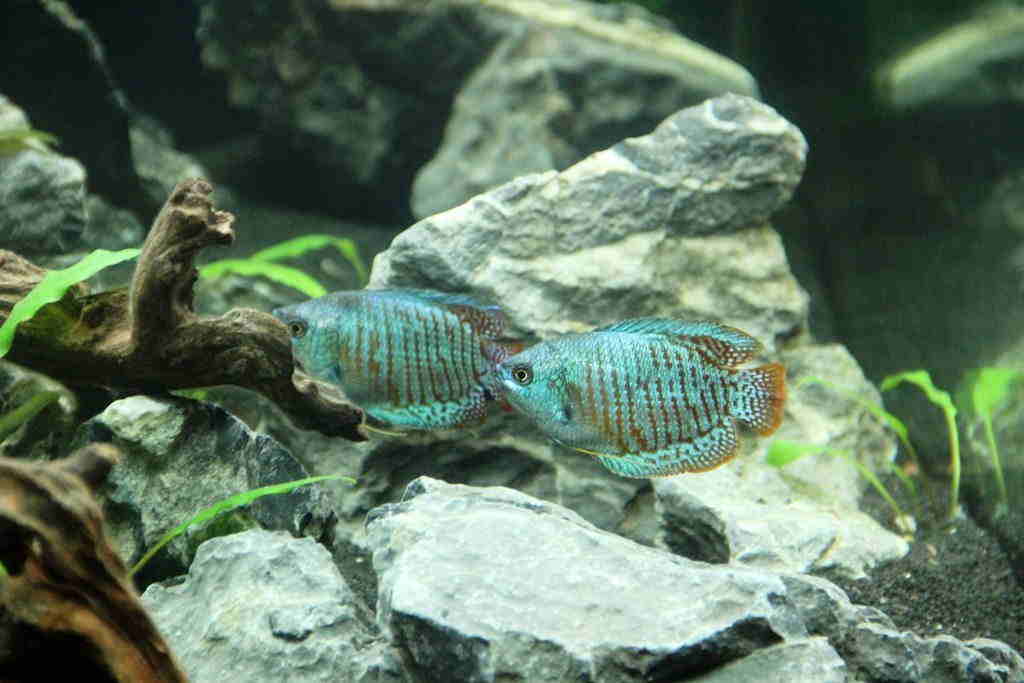
Tank mates
Dwarf gouramis can be compatible with various peaceful community fish species. When selecting tank mates for dwarf gouramis, it’s important to consider their relatively small size, peaceful nature, and specific tank requirements. Here are some suitable tank mates for dwarf gouramis:
- Harlequin Rasboras (Trigonostigma heteromorpha)
- Neon Tetras (Paracheirodon innesi)
- Ember Tetras (Hyphessobrycon amandae)
- Glowlight Tetras (Hemigrammus erythrozonus)
- Black Neon Tetras (Hyphessobrycon herbertaxelrodi)
- Cardinal Tetras (Paracheirodon axelrodi)
- Rummy Nose Tetras (Hemigrammus rhodostomus)
- Sparkling Gouramis (Trichopsis pumila)
- Celestial Pearl Danios (Danio margaritatus)
- White Cloud Mountain Minnows (Tanichthys albonubes)
- Dwarf Rasboras (Boraras spp.)
- Endler’s Livebearers (Poecilia wingei)
- Guppies (Poecilia reticulata)
- Platies (Xiphophorus spp.)
- Corydoras Catfish (Corydoras spp. – pygmy cory, panda cory, adolfoi catfish)
- Otocinclus Catfish (Otocinclus spp.)
- Bristlenose Plecos (Ancistrus spp.)
Are dwarf gouramis aggressive?
Dwarf gouramis are not typically considered schooling fish. In their natural habitat, they are known to be solitary or form small social groups rather than large schools.
Dwarf gouramis are generally peaceful fish, but like many other fish species, they can exhibit territorial and aggressive behavior under certain circumstances. Dwarf gourami with some reserve can be recommended to be kept in community tanks. They’ll definitely be good tank mates for quite a number of other fish kinds, however, at that they aren’t the best ones, since this species is very timid and territory-dependent, therefore in a small tank they should be considered as the only one male gourami.
Male dwarf gouramis can become territorial, especially during breeding or when kept with other males. They may display aggression towards other males, including chasing, fin-nipping, and even fighting. It’s recommended to keep only one male dwarf gourami per tank to minimize aggression.
While less common, females can also exhibit territorial behavior, particularly when they are guarding their fry or if they feel threatened. It’s essential to provide enough hiding places and space to reduce potential conflicts.
If you plan to keep multiple dwarf gouramis, it’s generally recommended to have a higher ratio of females to males. This can help distribute aggression and minimize conflicts between males.
Gender differences: male vs female
Dwarf gouramis have rather strongly marked dimorphism. There are several physical and behavioral differences between male and female dwarf gouramis (Trichogaster lalius). Here are some key characteristics that can help you distinguish between the two:
- Size: The male is rather large (7.5 cm) and its body has bright blue and red vertical stripes, whereas the female is small (6 cm long) and it has rather simple silvery coloring.
- Coloration: Male dwarf gouramis have more vibrant and intense colors compared to females. Males often exhibit iridescent patterns, with shades of blue, red, and orange, while females have more subdued and less striking coloration.
- Fins: Males typically have more elongated fins compared to females. Their dorsal (top) fin and anal (bottom) fin may have more extended filaments or flowing edges, giving them a more elaborate appearance. In contrast, females have shorter and less exaggerated fins.
- Body Shape: Male dwarf gouramis have a more slender and streamlined body shape compared to females. Females tend to have a slightly rounder and fuller body, particularly when they are carrying eggs.
- Behavior: Males are more territorial and can display aggressive behavior, especially during breeding. They may exhibit flaring, chasing, and fin displays to assert dominance and attract females. Females are generally more peaceful and less aggressive.
- Bubble Nest Building: Male dwarf gouramis are bubble nest builders. During breeding, the males create elaborate bubble nests at the water surface to house and protect the fertilized eggs. Females do not participate in nest-building and focus on laying eggs.
Breeding
Becomes reproductive when being 4-5 cm long. As many other Anabantoidei fish, dwarf gourami are bubble nest builders. Breeding is quite an easy process and only spontaneous behavior of the male may give some trouble.
A tank of 2-4 gallons capacity can be used as a spawning tank. The water level should be about 10 cm high, since dwarf gourami juveniles are born without completely developed labyrinth organ and they require some easily accessible oxygen.
The water should be soft, about 4 -6°dH. You don’t have to put any substrate on the spawning tank bottom, however to soften the water you may put about 2 pieces of turf in the tank. The tank should have a lid on top, since the juveniles need some warm humid air to breathe. Some breeders put polythene film on top of the tank for this purpose.
If not provided with required hothouse conditions, the development of the labyrinth organ may take significantly longer.
In the tank corners there should be lots of plants, so dwarf gourami female has some place to hide from the aggressive male during the spawning period. Put some Riccia on the water surface, since it is actively used by the male to build its nest of bubbles.
Couple should be separated before they are put into a spawning tank to get completely ready for spawning. Their diet should include a variety of live and frozen feed. When the dwarf gourami female becomes rounded with the eggs inside it, it’s put into the spawning tank and during the next week it’s getting used for the new environment.
If everything goes fine, the dwarf gourami male starts building a nest – it creates some construction of bubbles on the water surface, using some plants to strengthen the construction.
During this period of time male starts to attack the female and therefore there should definitely be some covers and plants in the tank.
Once the nest is built, the dwarf gourami change their behavior. The male stops being aggressive to the female one, and the latter becomes a dominant fish. The female swims under the nest and touches the male with its face. The spawning occurs under the nest with the “embraces” typical for Anabantoidei fish.
The male embraces the female one with its body and the eggs and sperm are output simultaneously. Then the couple goes apart and the female gets down on the tank bottom. The fertilized eggs have positive buoyancy and they go up to the bubble nest.
The dwarf gourami male then gathers those eggs that are scattered around the tank. The female lays the eggs several times. After the spawning is over male starts haunting and beating the female and it can even kill her. That’s why you should remove her from the tank once the spawning is over.
Male himself takes care after the nest. He adds some air bubbles, removes spoilt eggs, and guards the nest. The incubation period is about 48 hours.
About 3-4 days later the juveniles will start to swim. Now you can remove the male from the spawning tank and start feeding juveniles with infusorians and crustaceans nauplii or at least with some egg yolk.
The juveniles grow comparatively slow and they have different rate of growth, so it’s necessary to sort them from time to time. With the time you may start feeding them with more large sized feed. When the juveniles become about 1.5-2 month old the stripes specific to adult fish appear on the body.